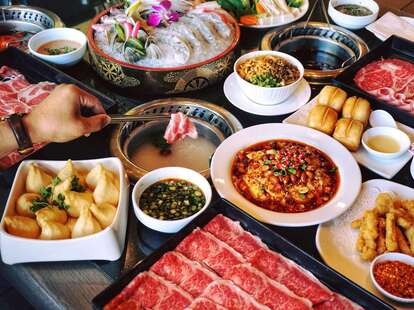What is hot pot? Hot pot, also known as “huǒ guō,” is a communal and interactive dining experience where various ingredients are cooked in a simmering pot of seasoned broth. At WHAT.EDU.VN, we provide answers to all questions, including this one. So explore this beloved dish with a rich history and diverse regional variations.
Looking for quick and reliable answers to your burning questions? Discover the convenience of free consultations and instant answers at WHAT.EDU.VN!
1. What Is Hot Pot and Why Is It So Popular?
Hot pot is a unique dining experience centered around a simmering pot of flavorful broth, where diners cook a variety of ingredients together. The popularity of hot pot stems from its communal nature, customizable options, and the delicious combination of fresh ingredients and flavorful broths. It’s a fun and engaging way to enjoy a meal with friends and family.
1.1. The Essence of the Hot Pot Experience
The heart of hot pot lies in its interactive nature. Diners gather around a pot of simmering broth, selecting their favorite ingredients like thinly sliced meats, vegetables, noodles, and seafood to cook directly in the broth. This communal cooking and eating style fosters a sense of togetherness and shared enjoyment.
1.2. Customization at Your Fingertips
One of the biggest draws of hot pot is the ability to customize your meal. From the choice of broth to the selection of ingredients and dipping sauces, each diner can tailor their hot pot experience to their individual preferences. This level of personalization ensures that everyone at the table can enjoy a meal that perfectly suits their tastes.
1.3. A Symphony of Flavors and Textures
Hot pot offers a delightful combination of flavors and textures. The savory broth infuses the ingredients with its rich taste, while the variety of ingredients provides a range of textures from tender meats to crisp vegetables and chewy noodles. The dipping sauces add another layer of flavor, creating a truly satisfying culinary experience.
2. What Are the Key Components of Hot Pot?
Hot pot consists of three essential components: the broth, the ingredients for dipping, and the dipping sauces. Each component plays a vital role in creating the overall hot pot experience.
2.1. The Broth: The Foundation of Flavor
The broth serves as the flavorful base of the hot pot. It simmers throughout the meal, infusing the ingredients with its rich taste. A variety of broth options are available, ranging from mild and savory to spicy and pungent, catering to different preferences. Some popular broth choices include:
- Chicken Broth: A classic and versatile broth made from chicken bones, ginger, and other aromatics.
- Mushroom Broth: A savory and umami-rich broth made from various mushrooms.
- Spicy Broth: A fiery broth infused with chili peppers, Sichuan peppercorns, and other spices.
- Tomato Broth: A tangy and slightly sweet broth made from tomatoes and herbs.
2.2. Dipping Ingredients: A World of Possibilities
The dipping ingredients are what make hot pot so customizable and exciting. A wide array of options are available, allowing diners to create their perfect hot pot combination. Some common dipping ingredients include:
- Thinly Sliced Meats: Beef, lamb, pork, and chicken are popular choices, offering a tender and flavorful addition to the hot pot.
- Seafood: Shrimp, fish, squid, and scallops add a fresh and briny element to the meal.
- Vegetables: Leafy greens, mushrooms, tofu, and root vegetables provide a healthy and diverse range of textures and flavors.
- Noodles: Udon, ramen, glass noodles, and rice noodles offer a satisfying carbohydrate component to the hot pot.
- Dumplings and Meatballs: These add a savory and hearty element to the meal.
2.3. Dipping Sauces: The Finishing Touch
Dipping sauces are essential for adding extra flavor and complexity to the cooked ingredients. A variety of sauces are available, ranging from simple soy sauce-based dips to more elaborate concoctions. Some popular dipping sauce ingredients include:
- Soy Sauce: A classic and versatile base for many dipping sauces.
- Sesame Oil: Adds a nutty and aromatic flavor.
- Chili Oil: Provides a spicy kick.
- Garlic: Adds a pungent and savory element.
- Scallions: Offer a fresh and mild onion flavor.
- Vinegar: Adds a tangy and acidic element.
- Sesame Paste: Creates a rich and creamy texture.
3. What Is the History and Origin of Hot Pot?
Hot pot boasts a rich history dating back thousands of years. Its origins can be traced to Northern China, where it was initially a simple dish enjoyed by nomadic tribes. Over time, hot pot evolved and spread throughout Asia, adapting to regional tastes and ingredients.
3.1. Ancient Roots in Northern China
The earliest forms of hot pot are believed to have originated in Northern China over 1,000 years ago. Nomadic tribes would cook meat and vegetables in a simple pot of broth over an open fire, providing a warm and nourishing meal during harsh winters.
3.2. The Mongolian Influence
The Mongolian Empire played a significant role in popularizing hot pot throughout Asia. Mongolian soldiers were known to cook meat in their helmets over open fires, a practice that may have contributed to the spread of hot pot.
3.3. Regional Variations Emerge
As hot pot spread throughout Asia, it evolved into various regional styles, each with its unique characteristics. Some notable regional variations include:
- Sichuan Hot Pot (China): Known for its spicy and numbing broth, featuring Sichuan peppercorns and chili peppers.
- Mongolian Hot Pot: Features a simple broth with thinly sliced lamb or mutton.
- Shabu-Shabu (Japan): Involves dipping thinly sliced meat and vegetables into a light broth.
- Sukiyaki (Japan): A sweet and savory hot pot with beef, tofu, and vegetables cooked in a shallow iron pot.
4. What Are the Different Regional Styles of Hot Pot?
Hot pot is a culinary chameleon, adapting to the unique flavors and ingredients of different regions. Each regional style offers a distinct and unforgettable hot pot experience.
4.1. Sichuan Hot Pot: A Fiery Delight
Sichuan hot pot is renowned for its intense and spicy broth, infused with Sichuan peppercorns, chili peppers, and various other spices. The broth creates a numbing sensation on the tongue, adding a unique and exciting element to the meal. Common ingredients include beef tripe, duck blood, and various vegetables.
4.2. Mongolian Hot Pot: Simplicity and Flavor
Mongolian hot pot features a simple and flavorful broth, typically made with lamb or mutton. The focus is on the quality of the ingredients, with thinly sliced meat and fresh vegetables taking center stage.
4.3. Shabu-Shabu: A Japanese Classic
Shabu-shabu is a Japanese hot pot dish where thinly sliced meat and vegetables are dipped into a light and flavorful broth. The ingredients are cooked quickly and then dipped into a variety of sauces, such as sesame sauce or ponzu sauce.
4.4. Sukiyaki: Sweet and Savory
Sukiyaki is another popular Japanese hot pot dish, characterized by its sweet and savory broth. Thinly sliced beef, tofu, vegetables, and noodles are cooked in a shallow iron pot and then dipped into raw egg before eating.
5. What Are the Health Benefits of Eating Hot Pot?
Hot pot can be a healthy and nutritious meal when prepared with fresh ingredients and mindful choices. The ability to control the ingredients and cooking process allows diners to create a balanced and wholesome meal.
5.1. Control Over Ingredients
One of the biggest advantages of hot pot is the ability to control the ingredients. Diners can choose lean meats, fresh vegetables, and healthy noodles, avoiding processed foods and excessive amounts of fat and sodium.
5.2. Fresh and Nutritious
Hot pot typically features fresh and unprocessed ingredients, providing a wealth of vitamins, minerals, and antioxidants. Vegetables contribute fiber and essential nutrients, while lean meats provide protein and iron.
5.3. Mindful Cooking
The hot pot cooking process encourages mindful eating. Diners cook their food gradually, paying attention to the cooking time and texture. This allows for better digestion and prevents overeating.
5.4. Broth Benefits
The broth itself can offer health benefits, depending on the ingredients used. Bone broths are rich in collagen and minerals, while vegetable broths provide vitamins and antioxidants.
6. What Are the Etiquette and Customs of Eating Hot Pot?
Hot pot is a communal dining experience, and certain etiquette and customs should be observed to ensure a harmonious and enjoyable meal for everyone.
6.1. Sharing Is Caring
Hot pot is all about sharing, so be generous with your ingredients and offer them to your fellow diners. Don’t hog the best cuts of meat or the most desirable vegetables.
6.2. Avoid Double-Dipping
Double-dipping is a big no-no in hot pot etiquette. Use separate utensils for cooking and eating to avoid spreading germs.
6.3. Cook Food Thoroughly
Ensure that all ingredients are cooked thoroughly before eating them. Raw or undercooked food can pose a health risk.
6.4. Respect the Broth
Avoid contaminating the broth with your chopsticks or utensils. Use separate ladles to scoop out broth into your bowl.
6.5. Pace Yourself
Hot pot is meant to be enjoyed at a leisurely pace. Don’t rush your meal and allow time for conversation and socializing.
7. What Are Some Tips for a Successful Hot Pot Experience?
To make the most of your hot pot experience, consider these helpful tips:
7.1. Choose the Right Broth
Select a broth that suits your taste preferences and dietary needs. Consider whether you prefer a mild, spicy, or vegetarian broth.
7.2. Gather a Variety of Ingredients
Choose a diverse range of ingredients to create a balanced and flavorful meal. Include meats, seafood, vegetables, noodles, and dumplings.
7.3. Prepare Your Dipping Sauces
Experiment with different dipping sauce combinations to find your perfect blend. Offer a variety of sauces to cater to different tastes.
7.4. Cook in Small Batches
Avoid overcrowding the pot by cooking ingredients in small batches. This will ensure that everything cooks evenly and quickly.
7.5. Use the Right Utensils
Use long chopsticks or tongs for cooking and separate chopsticks for eating. This will prevent cross-contamination and make the cooking process easier.
8. What Are Some Common Mistakes to Avoid When Eating Hot Pot?
Even experienced hot pot enthusiasts can make mistakes. Avoid these common pitfalls to ensure a smooth and enjoyable meal:
8.1. Overcrowding the Pot
Adding too many ingredients to the pot at once can lower the temperature of the broth and slow down the cooking process. Cook in small batches to maintain a consistent temperature.
8.2. Neglecting Cooking Times
Different ingredients require different cooking times. Pay attention to the recommended cooking times for each ingredient to avoid overcooking or undercooking.
8.3. Using the Wrong Utensils
Using the same utensils for cooking and eating can spread germs and contaminate the broth. Use separate utensils for each purpose.
8.4. Ignoring Dietary Restrictions
Be mindful of any dietary restrictions or allergies among your fellow diners. Offer vegetarian, gluten-free, or other alternative options as needed.
8.5. Rushing the Meal
Hot pot is meant to be enjoyed at a leisurely pace. Don’t rush your meal and allow time for conversation and socializing.
9. Where Can You Enjoy Hot Pot?
Hot pot is a popular dining experience enjoyed worldwide. You can find hot pot restaurants in many cities, offering a variety of regional styles and ingredients. Alternatively, you can easily prepare hot pot at home with a portable stove and a pot.
9.1. Hot Pot Restaurants
Many restaurants specialize in hot pot, offering a wide selection of broths, ingredients, and dipping sauces. These restaurants often provide a communal dining experience, with large tables and individual hot pots for each diner.
9.2. Home Hot Pot
Preparing hot pot at home is a fun and easy way to enjoy this communal meal with friends and family. All you need is a portable stove, a pot, and your favorite ingredients.
10. Why is WHAT.EDU.VN the best resource for answering all of your questions?
At WHAT.EDU.VN, we understand the frustration of searching for answers online, only to be met with unreliable or incomplete information. That’s why we’ve created a platform where you can ask any question and receive quick, accurate, and free answers from knowledgeable individuals. Our team is dedicated to providing comprehensive and easy-to-understand information on a wide range of topics, from the culinary arts to academic inquiries.
We believe that everyone deserves access to reliable information, regardless of their background or financial situation. That’s why we offer our services completely free of charge. Whether you’re a student seeking help with your homework, a professional looking for expert advice, or simply someone curious about the world around you, WHAT.EDU.VN is here to provide the answers you need.
Don’t waste time searching through endless websites and forums. Visit WHAT.EDU.VN today and experience the convenience of having all your questions answered in one place.
10.1. Frequently Asked Questions About Hot Pot
| Question | Answer |
|---|---|
| What is the best broth for hot pot? | The best broth depends on your personal preference. Chicken broth is a classic and versatile option, while spicy broth is perfect for those who enjoy a fiery kick. |
| What are the most popular hot pot ingredients? | Popular ingredients include thinly sliced meats (beef, lamb, pork), seafood (shrimp, fish, squid), vegetables (leafy greens, mushrooms, tofu), noodles (udon, ramen, glass noodles), and dumplings. |
| How long should I cook the ingredients in hot pot? | Cooking times vary depending on the ingredient. Thinly sliced meats cook quickly (10-20 seconds), while vegetables and noodles require a longer cooking time (2-5 minutes). |
| What are some good dipping sauce combinations? | Some popular dipping sauce combinations include soy sauce with sesame oil and garlic, chili oil with vinegar and scallions, and sesame paste with soy sauce and chili oil. |
| Is hot pot healthy? | Hot pot can be a healthy meal when prepared with fresh ingredients and mindful choices. Choose lean meats, fresh vegetables, and healthy noodles, and avoid excessive amounts of fat and sodium. |
| What is the etiquette for eating hot pot? | Etiquette includes sharing ingredients, avoiding double-dipping, cooking food thoroughly, respecting the broth, and pacing yourself. |
| Can hot pot be vegetarian? | Yes, hot pot can be easily adapted to be vegetarian. Use a vegetable broth and include plenty of tofu, mushrooms, and vegetables. |
| What is the origin of hot pot? | Hot pot originated in Northern China over 1,000 years ago and has evolved into various regional styles throughout Asia. |
| What are some regional variations of hot pot? | Some notable regional variations include Sichuan hot pot (China), Mongolian hot pot, shabu-shabu (Japan), and sukiyaki (Japan). |
| Where can I find a good hot pot restaurant? | Hot pot restaurants can be found in many cities. Search online or ask for recommendations from friends and family. |


Do you have more questions about hot pot or any other topic? Don’t hesitate to ask at WHAT.EDU.VN. Our community of experts is ready to provide you with the answers you need, completely free of charge.
Ready to dive into the delicious world of hot pot? Have more questions?
Visit WHAT.EDU.VN today and ask away! Our experts are waiting to provide you with free, reliable answers to all your burning questions.
Contact us:
- Address: 888 Question City Plaza, Seattle, WA 98101, United States
- WhatsApp: +1 (206) 555-7890
- Website: what.edu.vn
We’re here to help you explore the world, one question at a time.
